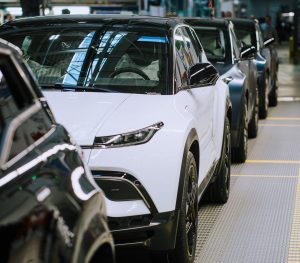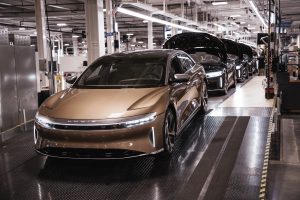Nascent EV maker Fisker’s battle to stay solvent now has the company adopting a new strategy: low-cost EV maker. The company slashed prices across its lineup by as much as 39%, including a low sticker of just under $25K.
The company announced it’s lowering the sticker price on its 2023 Ocean Extreme model from $61,499 to $37,499 — a $24,000 cut. Additionally, the company’s 2023 Ultra trim drops from $52,999 to $34,999 and the Ocean Sport falls to $24,999 from $38,999.
All of the vehicles involved in the massive price cuts are 2023 models with 2024 Ocean OS 2.0 installed, the company notes. The new prices go into effect Friday. The move to cut prices represents a new plan by the California-based EV company.
“Fisker is strategically positioning the all-electric Ocean SUV to be a more affordable and compelling EV choice,” the company said in release, “competitively available to EV buyers in the broadest possible market, and constantly improving via frequent over-the-air software updates.”

Fisker reportedly was negotiating a deal with Nissan which would see the Japanese automaker assemble the Fisker Alaska pickup — but the talks fell apart.
Liquidity issues
While the company says this represents a new strategy, the company’s ongoing liquidity issues and their possible role in this price slashing effort cannot be ignored. The company has been trying remain afloat while looking for additional investors.
The company previously was close to a $400 million deal with Nissan to assemble a version of its Alaska electric pickup for the Japanese automaker. However, the talks came to a halt, which also brought trading of the company’s shares on Nasdaq to a halt as well.
Fisker’s fortunes have been looking increasingly bleak for months, with production and sales lagging far behind expectations, losses mounting and the company’s cash reserves all but gone. Then, late last month, Fisker’s eponymous founder, Henrik Fisker warned there was “substantial doubt about Fisker’s ability to continue as a going concern.”

Fisker took an unusual approach, outsourcing production of the Ocean to Magna Steyr, a contract assembler in Austria.
But barely a week later, news surfaces that the startup was in “advanced talks” that could lead to a new partnership. That new deal being the aforementioned $400 million from Nissan. Officials at the company were very optimistic at the time.
“There is a high likelihood of this happening,” a deeply placed insider advised Headlight.News, saying that the goal was to reach an agreement by the end of the month.
MORE FISKER NEWS
- Fisker Shares Collapse on Bankruptcy Report
- Consumer Reports Reviews Calls Fisker Ocean “Inexcusable.”
- Fisker Says His Company’s Future is in “Substantial Doubt”
Second time around
Fisker Inc. is the second attempt at creating a green-focused car company by Henrik Fisker, a one-time automotive designer known for his work at Aston Martin. His original firm, Fisker Automotive, produced the ill-fated Karma plug-in hybrid. As is the case with Fisker Inc., that company burned through its cash horde and was unable to raise new capital. It went into Chapter 7 bankruptcy, its remaining assets sold to a Chinese company now renamed Karma.
Fisker is by no means the only EV startup that’s been struggling lately. Some, like Faraday Future and Lucid, are barely functional. Others, such as Lucid, have been kept alive with the help of deep-pocketed partners.
Fisker had hoped to avoid the pitfalls that have tripped up some of those other EV wannabes. Instead of setting up its own assembly line — typically a billion dollar project — it decided to turn to an outside manufacturer. Ocean has been rolling out of a plant in Graz, Austria operated by Magna Steyr. But the partnership has been plagued by supplier disruptions, shortages, design issues and manufacturing problems.








0 Comments